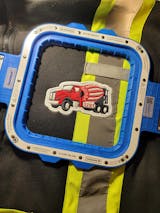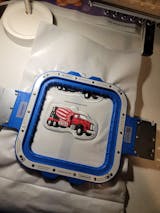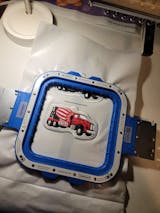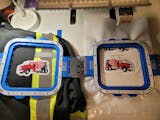1. Introduction to Rod Wrap Thread Essentials
Rod wrapping is more than just a finishing touch—it's the backbone of every custom fishing rod. The thread you choose to secure your guides directly impacts not only the rod’s strength and durability but also its visual appeal. Whether you’re aiming for a subtle, seamless look or a bold, decorative statement, understanding the fundamentals of rod wrap thread is essential for both performance and aesthetics. In this guide, we’ll unravel the core types of thread, explore how to select the right material and size, and introduce you to the latest innovations in wrapping tools. Ready to elevate your rod-building skills? Let’s dive into the details that make every wrap count.
Table of Contents
- 1. Introduction to Rod Wrap Thread Essentials
- 2. Rod Wrap Thread Types and Material Properties
- 3. Choosing the Optimal Rod Wrap Thread
- 4. Step-by-Step Rod Wrapping Techniques
- 5. Essential Tools for Precision Wrapping
- 6. Alternative Materials and Creative Customization
- 7. Troubleshooting Common Wrapping Issues
- 8. Conclusion: Building Rods with Confidence
- 9. Rod Wrap Thread FAQ
2. Rod Wrap Thread Types and Material Properties
Selecting the right thread material is the first step toward building a rod that stands up to the elements and looks sharp on the water. Let’s break down the main contenders—nylon, polyester, metallic, and silk—so you can match your thread to your fishing style and environment.
2.1 Nylon vs. Polyester: Core Differences
When it comes to rod wrapping, nylon and polyester threads are the workhorses of the craft. But what sets them apart?
| Property | Nylon | Polyester |
|---|---|---|
| Stretch | Moderate stretch for tight wraps | Less stretch, requires tighter tension |
| UV Resistance | Low (protected by finish) | High, ideal for sun/UV exposure |
| Color Stability | Can darken with finish, less stable | Maintains color, even after finish |
| Strength | Durable, resists abrasion | Higher tensile strength, abrasion-resistant |
| Best For | Freshwater, shaded use, ease of use | Saltwater, harsh UV, long-term color |
Nylon threads are prized for their flexibility and ease of use, making them a go-to for general guide wrapping—especially in freshwater or shaded conditions. Their stretch allows for tight, secure wraps, but they can degrade under prolonged UV exposure. Applying an epoxy finish helps, but color may still darken, especially with darker threads.
Polyester threads, on the other hand, shine in saltwater and sunny environments. They boast superior UV resistance and maintain vibrant colors even after finishing. While polyester is stiffer and demands more tension during wrapping, its high tensile strength and colorfastness make it the top pick for rods that see a lot of sun and salt.
Pro tip: If you’re after long-term durability and consistent color, especially for saltwater rods, polyester is your ally. For ease of handling and cost-effectiveness, nylon is a solid choice for freshwater builds.
2.2 Specialty Threads: Metallic and Silk Applications
Looking to add a touch of flair or vintage charm to your rod? Metallic and silk threads offer unique possibilities, but come with their own set of trade-offs.
Metallic Threads
- Pros: Nothing beats the shimmer of metallic threads for decorative accents like butt wraps or trim bands. Available in a spectrum of colors (think gold, silver, and beyond), they’re perfect for customizing your rod’s appearance.
- Cons: Metallic threads are less flexible and not as strong as nylon or polyester, making them unsuitable for structural guide wraps. Their rigidity can challenge beginners, and if scratched, they may lose their luster or even risk line damage.
- Best For: Decorative elements where visual impact is key and strength is secondary.
Silk Threads
- Pros: Silk is the thread of choice for traditionalists and those seeking a premium, glossy finish. Its ultra-smooth texture and minimal bulk make it ideal for intricate decorative work and “invisible” wraps.
- Cons: Silk lags behind synthetics in durability, UV, and water resistance. It’s rarely used in modern rod building except for vintage or niche projects, and it requires more care and maintenance.
- Best For: Niche builds where aesthetics and tradition outweigh long-term durability.
Key Takeaway: Use metallic and silk threads to elevate your rod’s visual appeal, but reserve nylon or polyester for the heavy lifting of securing guides. Match your thread not just to your style, but to the conditions your rod will face.
3. Choosing the Optimal Rod Wrap Thread
With so many options on the table, how do you zero in on the best thread for your next build? It all comes down to matching size, material, and brand to your rod’s needs and your own skill level.
3.1 Thread Size Guide: A, D, E Demystified
Thread size isn’t just a number—it’s a decision that shapes your rod’s performance and look. Here’s how the most common sizes stack up:
| Size | Diameter | Use Case | Key Features |
|---|---|---|---|
| A | ~0.006" | Delicate rods, decorative wraps | Smooth finish, minimal bulk, more wraps needed |
| D | ~0.012" | General-purpose freshwater/saltwater | Balances bulk and ease, common for guide securing |
| E | Thickest | Heavy-duty saltwater/big game | Robust hold, challenging for beginners/detailed work |
- Size A: Go-to for intricate designs and lightweight rods. Its fine diameter delivers a sleek, minimal look, but you’ll need more wraps for security.
- Size D: The all-rounder. It’s easy to handle, provides a sturdy hold, and is favored for most guide wraps on both freshwater and saltwater rods.
- Size E: Built for the big leagues—think heavy-duty saltwater or big game rods. It’s robust but can be unwieldy for beginners or detailed work.
Gudebrod Specs Reference:
| Thread Size | Diameter | Break Strength | Typical Use |
|---|---|---|---|
| Gudebrod A | 0.007" | 3.5 lbs | Small guides |
| Gudebrod C | 0.0108" | 4.5 lbs | Medium guides |
| Gudebrod D | 0.012" | 5.1 lbs | Heavy-duty guides |
Pro tip: Choose thread size based on the rod’s intended use and your comfort level. Beginners often find Size D easiest to manage, while advanced builders may opt for Size A or silk for detailed wraps.
3.2 Environmental and Skill-Based Selection
Not all threads are created equal when it comes to battling the elements—or matching your experience level.
| Factor | Recommendation | Rationale |
|---|---|---|
| Saltwater Use | Size D/E, Color Fast | Higher tensile strength, UV resistance |
| Freshwater Use | Size A/D, standard nylon | Adequate durability, lighter weight |
| Beginners | Size D, nylon/polyester | Easier to handle, fewer wraps needed |
| Advanced Builders | Size A, silk | Enables intricate designs, smooth finish |
- Saltwater rods demand threads that can withstand UV and corrosion—think polyester or colorfast nylon in larger sizes.
- Freshwater rods can get by with standard nylon or polyester, with more flexibility in size and color.
- Beginners should start with Size D nylon or polyester for a forgiving, manageable experience.
- Advanced builders can explore finer threads and silk for custom aesthetics.
Brand Comparisons:
| Brand | Strengths | Weaknesses |
|---|---|---|
| ProWrap | 80+ colors, UV-resistant, multiple spools | Occasional thread-twist issues |
| Fuji Ultra Poly | Easy packing, minimal “fuzzies” | Limited color options |
| Hitena | Slightly thicker than A (size B), smooth | Fewer color choices |
- ProWrap leads in color variety and UV resistance, making it a favorite for creative and outdoor builds.
- Fuji Ultra Poly stands out for smooth handling and consistent quality, even if the color palette is more limited.
- Hitena offers smoothness and a unique size option for those seeking something different.
Bottom Line: Prioritize thread size for your rod type, material for environmental demands, and brand for color and handling preferences. The right combination will make your wraps not only functional but a true reflection of your craftsmanship.
Ready to put these insights into action? In the next section, we’ll walk through hands-on wrapping techniques, so you can turn your thread choice into a flawless, professional finish.
4. Step-by-Step Rod Wrapping Techniques
Mastering rod wrapping is like learning to dance with your hands—each move matters, and the right rhythm yields a flawless finish. Whether you’re a first-timer or a seasoned builder, nailing the setup, tag-end management, and guide securing will make your wraps both durable and eye-catching. Let’s break down the process, step by step.
4.1 Setup and Tag-End Management
Before you even touch the thread, preparation is your secret weapon. Start by choosing the right thread—nylon for flexibility, polyester for UV resistance, and the correct size (A for detail, D for all-purpose, E for heavy-duty). Load your thread spool into your wrapper’s tensioner, threading it through guides or eyebolts to ensure smooth, consistent tension. Adjust the spring or magnetic tensioner according to your project: tight for guide wraps, looser for decorative patterns.
To begin the wrap, position the tag end of your thread on the rod blank at your chosen starting point. For left-to-right wraps, place the tag end on the right side of the running thread. Cross the thread over itself to lock the tag end—no knots needed. Some builders prefer to tape the spiral in place for extra security, especially if you’re just starting out.
As you spiral the thread around the rod, use your fingers or a thread carriage to maintain hooping tension for consistent wraps. A slight angle—created by moving the carriage—helps the thread pull against itself, keeping each wrap tight and minimizing gaps. Aim for at least three turns to lock the tag end, though five or more can provide extra security. Remember, the more wraps, the bigger the bump on what’s affectionately called the “dirty side”—the underside of the rod where tag ends hide out of sight.
When you’re ready to secure the tag end, employ the pull-through method. Cut the running thread a couple of inches from the rod, pass it through a loop or under the wrap with a pull-through tool, and pull it beneath 6–8 wraps. This buries the tag end for a seamless look. Throughout, use your fingernail to straighten the leading edge and push threads together, closing any gaps as you go.
4.2 Guide Securing and Burnishing
Securing guides is where precision meets patience. Wrap the thread around the guide foot, maintaining consistent tension—tight enough for security, but not so tight that the thread frays. For spinning rods, align the seam on the upper side of the rod for a clean look. On heavy-duty builds, consider double over-wraps for extra strength.
Tension control is crucial. Adjust the wrapper’s tension rod or magnetic system as needed, and periodically test the tension as the spool unwinds. Consistency here means fewer headaches later.
Once the guide is secure, it’s time for burnishing—a fancy word for smoothing and perfecting your wraps. Use a burnishing tool: the flat side to square off the wrap and close gaps, the rounded side to polish the surface. This not only improves aesthetics but also ensures your wraps are structurally sound.
When trimming excess thread, reach for a razor blade and cut at a slight angle to prevent fraying. For an ultra-clean finish, some builders use a gentle heat source (like an alcohol torch) to melt the thread end, tucking it neatly under the wrap.
Pro tip: Always position tag ends and any minor imperfections on the rod’s underside. That way, your handiwork looks flawless from every angle when you’re out on the water.
5. Essential Tools for Precision Wrapping
The right tools don’t just make rod wrapping easier—they elevate your craftsmanship and ensure every wrap is tight, smooth, and built to last. Let’s explore the essentials, from hand wrappers to burnishers, and see how innovations from other crafts, like embroidery, can inspire your setup.
5.1 Hand vs. Power Wrappers Compared
Choosing between a hand wrapper and a power wrapper is a bit like picking between a trusty manual sewing machine and a high-speed industrial model—both have their place, depending on your needs.
Hand Wrappers
Hand wrappers, such as the Advanced Handwrapper System (AHWS), are beloved for their portability, affordability, and tactile control. They feature adjustable stands, precision knobs, and tension rods, making them ideal for beginners and hobbyists. The CRB 8-Spool Thread Carriage is a standout, allowing you to work with multiple threads and fine-tune tension for intricate or multi-color wraps. DIY alternatives—crafted from wood, springs, and bolts—offer budget-friendly options, though they may lack the precision of commercial systems.
Power Wrappers
Power wrappers are the workhorses for high-volume builders. These automated machines deliver consistent tension and speed, reducing physical effort and boosting efficiency. They’re perfect for those tackling multiple rods or seeking uniform results across projects. However, they require a dedicated workspace and come with a higher upfront cost.
| Feature | Hand Wrappers | Power Wrappers |
|---|---|---|
| Cost | Lower | Higher |
| Precision | Manual, detailed control | Automated, consistent |
| Portability | Compact, easy to store | Bulky, fixed setup |
| Efficiency | Slower for large projects | Fast, ideal for batch production |
For those just starting out or working on custom, one-off rods, a hand wrapper is often the way to go. If you’re scaling up or crave perfect uniformity, a power wrapper could be your new best friend.
5.2 Burnishers and Tension Systems
Burnishers are the unsung heroes of rod wrapping. These tools—ranging from specialized burnishing sticks to the humble edge of a ballpoint pen—flatten thread fibers, close gaps, and polish wraps before finishing. Think of them as the equivalent of an embroidery hoop in garment work: they stabilize your “canvas,” ensuring every thread lays flat and true.
Tension systems are equally vital. Whether you’re using a spring-loaded hand wrapper, a magnetic hoop tension system, or a tabletop thread tensioner, the goal is the same: maintain consistent thread tension for even, gap-free wraps. Adjustable tension rods allow you to dial in just the right resistance—tight for securing guides, looser for decorative patterns. The CRB 8-spool carriage and other modular systems make it easy to manage multiple threads and swap colors on the fly.
Here’s where cross-craft inspiration comes in. In embroidery, tools like Sewtalent magnetic hoops revolutionize fabric stability, allowing for precise, repeatable tension across complex garment designs. While rod wrapping and embroidery serve different ends, the principle is the same: stable tension equals professional results. For those who straddle both crafts, integrating a Sewtalent magnetic hoop into your embroidery workflow can bring the same consistency and ease you seek in rod building.
6. Alternative Materials and Creative Customization
Rod wrapping isn't just about function—it's a playground for creativity. From experimenting with alternative materials to mastering machine embroidery decorative patterns, there's plenty of room to make your rod truly your own. Let's explore the risks of braided line and the art of DIY customization.
6.1 Braided Line Risks and Feasibility
The idea of using braided fishing line for rod wraps pops up in forums and DIY circles, usually as a budget hack or emergency fix. But is it a smart substitute for traditional rod thread?
Feasibility: Braided line can be used in a pinch—especially for quick repairs—but it comes with a host of challenges. Its slick surface, often coated with lubricants, can prevent epoxy from bonding properly, resulting in "fisheyes" (dimples) and weak finishes. Unlike purpose-made rod threads, which are designed for optimal epoxy adhesion, braided line may require thorough cleaning with isopropyl alcohol before use—and even then, issues can persist.
Key Risks:
- Lubricant Interference: Lubricants in braided line can repel epoxy, leading to poor adhesion and structural weaknesses.
- Low Stretch: Braided line is stiffer and less elastic than nylon or polyester thread. This rigidity means it doesn't accommodate rod flex, increasing the risk of breakage—especially under heavy loads.
- UV Degradation: While braided lines are UV-resistant for fishing, they lack the long-term colorfastness and UV stabilizers found in rod threads. Over time, exposure can lead to fading and brittleness.
- Aesthetic Limitations: Color choices are limited, and the finish may not match the professional look of traditional threads.
| Factor | Braided Fishing Line | Traditional Rod Thread |
|---|---|---|
| Material | Polyethylene/Dyneema | Nylon/Polyester |
| Lubricants | Often present (affects epoxy) | None (epoxy-optimized) |
| Stretch | Low (risk of rod damage) | Moderate (accommodates flex) |
| UV Resistance | Moderate | High |
| Epoxy Compatibility | Poor (requires prep) | Excellent |
| Aesthetic | Limited colors | Wide range, metallic/silk options |
Bottom Line: For temporary fixes, braided line might get you back on the water. For permanent builds, stick with nylon or polyester rod thread—your rod (and your sanity) will thank you.
6.2 DIY Inlays and Trim Band Mastery
Customization is where rod building gets personal. Single-thread inlays, trim bands, and 3D effects can transform a plain wrap into a work of art. Here's how to get started, inspired by both rod wrapping and embroidery techniques.
Single-Thread Inlays:
- Cut a contrasting thread and tape it to the blank.
- Start your main wrap, taping the tag end down before the crossover.
- Insert a pull-through loop before locking the inlay in place.
- After five turns, pull the inlay thread through, trim, and continue wrapping.
- The result? A crisp, single-thread accent that pops against your main color.
3D Effects and Decorative Bands:
- Use multiple thread colors or metallic threads for bold, dimensional designs.
- Plan your pattern, pack threads tightly, and burnish as you go for a seamless look.
Parallel to Embroidery Precision: Just as embroidery artists rely on stable fabric tension for intricate designs, rod builders depend on consistent thread tension for clean inlays. In garment embroidery, tools like Sewtalent magnetic hoops provide this stability, especially for complex, multi-layered machine embroidery decorative patterns. The same principle applies here: the steadier your "canvas," the sharper your design.
If you're an embroidery enthusiast venturing into rod building, you'll appreciate how Sewtalent's magnetic hooping system delivers even tension across every project. That consistency is the secret to both flawless embroidery and show-stopping rod wraps.
7. Troubleshooting Common Wrapping Issues
Every rod builder—rookie or seasoned—hits a snag now and then. Maybe your thread starts to fray, your vibrant wraps fade to a dull memory, or your guides just won’t stay put. Before you let frustration unravel your hard work, let’s break down the most common wrapping headaches and how to fix them for good.
7.1 Solving Thread Fraying and Color Fade
Nothing saps your rod-building mojo faster than thread that splits or colors that fade before their time. But don’t worry—most of these issues come down to technique and material choice.
Thread Fraying: Fraying often sneaks in when you’re pulling your thread at a harsh 90-degree angle, ratcheting up the tension until the fibers give out. Instead, aim for a 45-degree angle—this sweet spot keeps the wraps snug without shredding your thread. It’s like finding the perfect tension on a guitar string: too tight and it snaps, too loose and it flops.
Choosing the right thread size also matters. Size A is great for delicate, detailed work, but it’s more prone to fraying on heavy-duty builds. Size D is the all-around hero for most freshwater and saltwater rods, while Size E brings the muscle for big game rods.
Color Fading: If your wraps are losing their luster, UV exposure is often the culprit—especially with lower-quality threads. The fix? Invest in threads with proven UV-resistant dyes and colorfastness ratings. After wrapping, seal the deal with a UV-protective finish to shield those colors from the sun’s relentless assault. Think of it as sunscreen for your rod.
Quick Prevention Checklist:
- Pull thread at a 45-degree angle for smooth tension.
- Match thread size to rod type and application.
- Choose high-quality, UV-resistant threads.
- Always finish with a UV-protective topcoat.
7.2 Epoxy Adhesion and Guide Stability Fixes
A beautiful wrap means nothing if your guides wobble or the epoxy peels off like a bad sticker. Here’s how to make sure your guides stay rock-solid and your finish lasts.
Epoxy Adhesion Failures: The biggest offenders? Using the wrong adhesive or skipping surface prep. Super glue and thread finishes just don’t cut it for structural bonds. Instead, reach for dedicated rod-building epoxies like ProGlü 5-Minute Epoxy for quick fixes, or Rod-Bond and Titebond III for handle and guide attachment. Before you even think about glue, sand and scuff both the guide feet and rod blank—removing any glossy finish ensures the epoxy bites in for a lasting hold.
Avoid applying epoxy to underwraps; they’re there to cushion, not to bond. Epoxy on underwraps can defeat their purpose and actually weaken the structure.
Guide Instability: If your guides are shifting mid-wrap, weak adhesive bonds or lack of temporary stabilization are likely to blame. Remove any old epoxy, reattach with proper adhesive, and use guide tubing to keep everything in place while you wrap. For extra flexibility, guide foot adhesives with low melting points let you reposition guides with a touch of heat.
Comparative Solutions for Adhesive Failures:
| Issue | Incorrect Approach | Recommended Fix |
|---|---|---|
| Guide Attachment | Super glue or thread finish | ProGlü 5-Minute Epoxy or Rod-Bond |
| Surface Prep | Skipping sanding/scuffing | Sand guide feet and rod surfaces |
| Underwrap Use | Applying epoxy to underwrap | Avoid epoxy on underwrap |
Key Preventive Measures:
- Pinch thread with your fingers during wrapping to maintain even tension.
- Use only dedicated adhesives for structural bonds.
- Always sand and prep surfaces before applying epoxy.
By dialing in your technique and choosing the right materials, you’ll sidestep the most common pitfalls and build rods that last—on the water and in your memory.
8. Conclusion: Building Rods with Confidence
Mastering rod wrap thread is about more than just technique—it’s about understanding your materials, dialing in perfect tension, and choosing the right tools for the job. Whether you’re chasing durability, vibrant aesthetics, or both, the right approach transforms every wrap into a signature of your craftsmanship. Don’t be afraid to experiment, but always respect the fundamentals. With each rod you build, your confidence—and your results—will only grow.
9. Rod Wrap Thread FAQ
9.1 Q: Can I reuse rod wrap thread?
A: It’s generally not recommended to reuse rod wrap thread. Once thread has been wrapped, tensioned, and finished, it may lose its structural integrity and colorfastness. For best results and longevity, always use fresh thread for each new wrap.
9.2 Q: What’s the difference between saltwater and freshwater threads?
A: Saltwater rods benefit from threads with higher UV resistance and tensile strength—think polyester or colorfast nylon in Size D or E. Freshwater rods can use standard nylon or polyester in lighter sizes. Always match your thread to the environment for optimal performance.
9.3 Q: How do I fix loose wraps?
A: If you notice a wrap coming loose, carefully unwind to the affected area, maintain proper tension as you rewrap, and use a burnishing tool to close any gaps. For persistent issues, check your thread size and tension system—consistent tension is key to tight, durable wraps.
Ready to put these fixes to work? Your next rod build is just a wrap away from perfection.








